Predictive Analytics: Impact on Stock Market and High-Volume Trading
VerifiedAdded on 2022/11/25
|8
|1463
|437
Report
AI Summary
This report examines the increasing use of predictive analytics in the finance sector, particularly its influence on stock market trading and high-volume transactions. It explores how businesses leverage analytical tools to understand customer needs and reduce risks. The report delves into the application of predictive analytics, including machine learning and data mining, to forecast future stock price movements and market trends. It highlights the shift from human-driven analysis to computer-based decision-making, emphasizing the importance of data accuracy and trend analysis. The report also discusses the wider scope of predictive analytics, its role in mitigating operational risks, and its potential for innovative solutions in the financial markets. The conclusion emphasizes the value of predictive models in volatile markets and the necessity of using vast datasets to increase the accuracy of results. The report references several academic sources to support its findings.
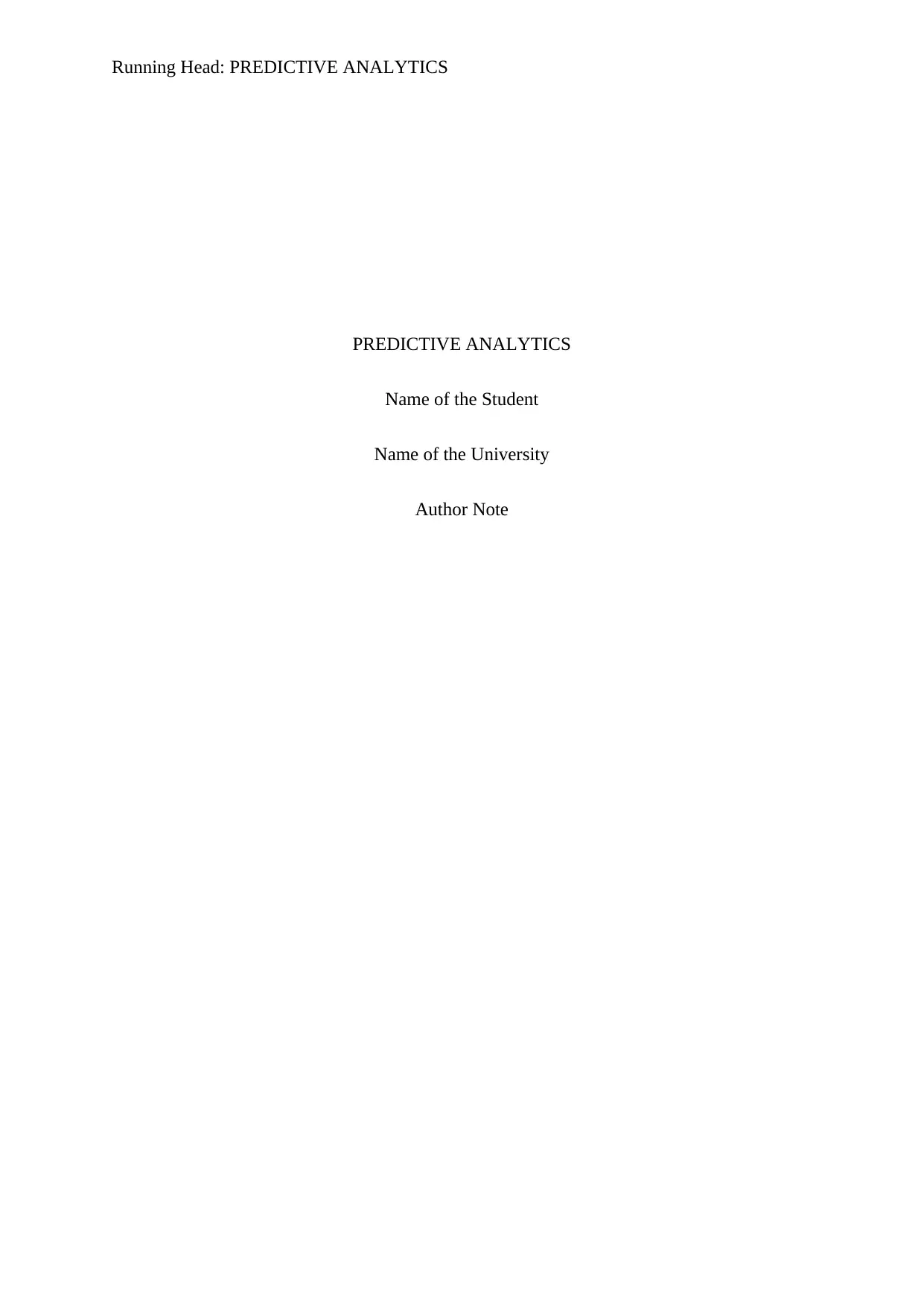
Running Head: PREDICTIVE ANALYTICS
PREDICTIVE ANALYTICS
Name of the Student
Name of the University
Author Note
PREDICTIVE ANALYTICS
Name of the Student
Name of the University
Author Note
Paraphrase This Document
Need a fresh take? Get an instant paraphrase of this document with our AI Paraphraser
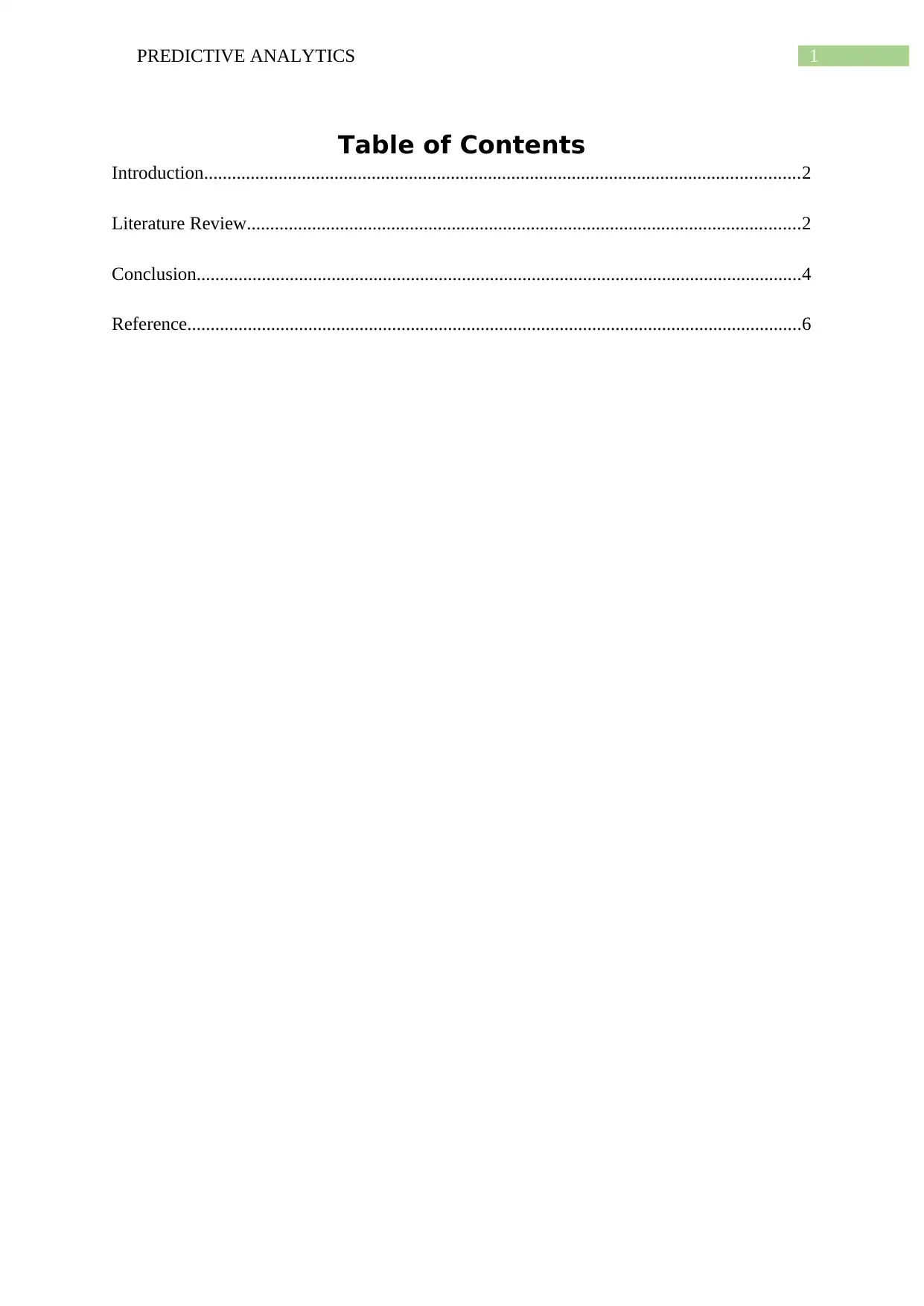
1PREDICTIVE ANALYTICS
Table of Contents
Introduction................................................................................................................................2
Literature Review.......................................................................................................................2
Conclusion..................................................................................................................................4
Reference....................................................................................................................................6
Table of Contents
Introduction................................................................................................................................2
Literature Review.......................................................................................................................2
Conclusion..................................................................................................................................4
Reference....................................................................................................................................6
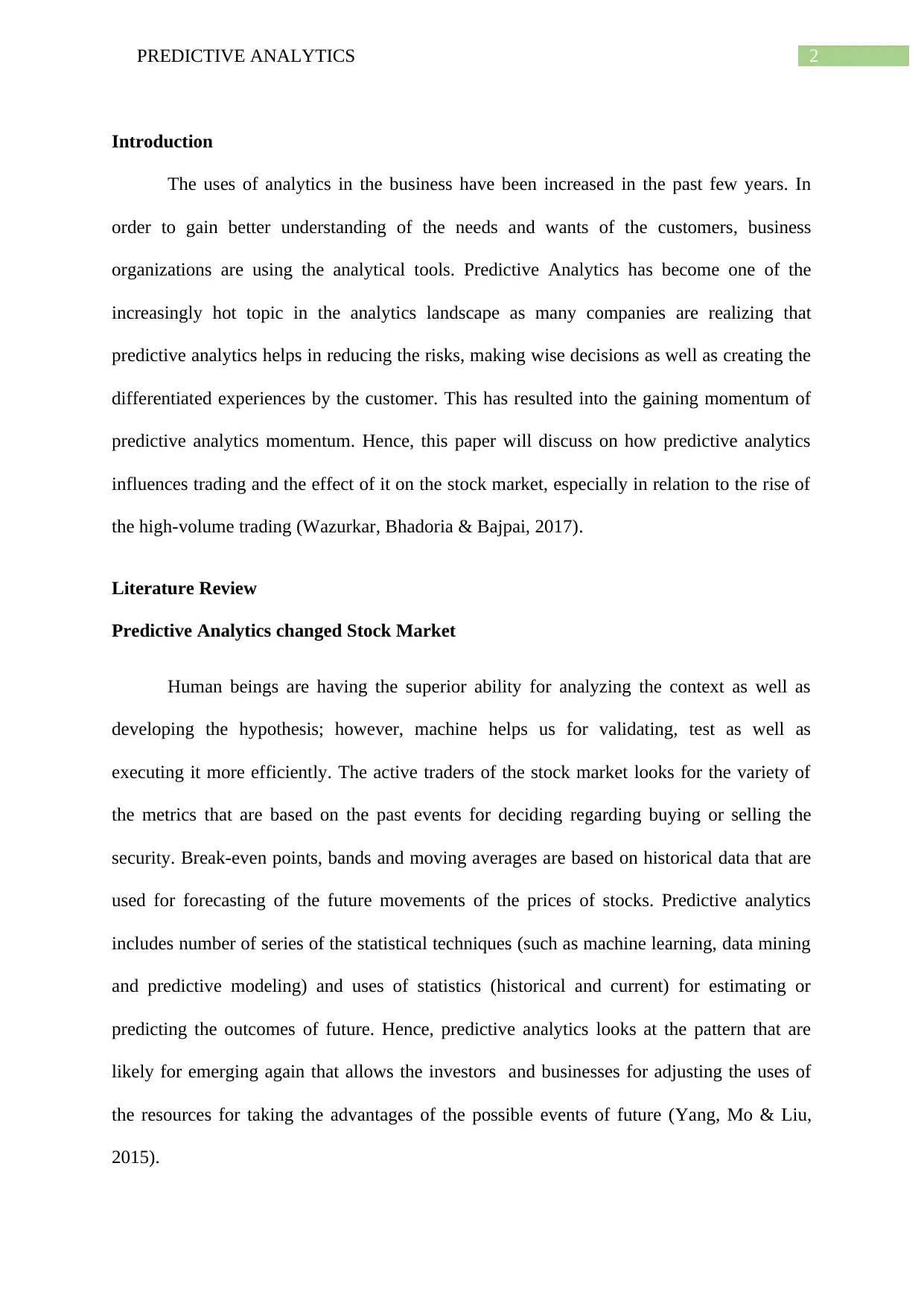
2PREDICTIVE ANALYTICS
Introduction
The uses of analytics in the business have been increased in the past few years. In
order to gain better understanding of the needs and wants of the customers, business
organizations are using the analytical tools. Predictive Analytics has become one of the
increasingly hot topic in the analytics landscape as many companies are realizing that
predictive analytics helps in reducing the risks, making wise decisions as well as creating the
differentiated experiences by the customer. This has resulted into the gaining momentum of
predictive analytics momentum. Hence, this paper will discuss on how predictive analytics
influences trading and the effect of it on the stock market, especially in relation to the rise of
the high-volume trading (Wazurkar, Bhadoria & Bajpai, 2017).
Literature Review
Predictive Analytics changed Stock Market
Human beings are having the superior ability for analyzing the context as well as
developing the hypothesis; however, machine helps us for validating, test as well as
executing it more efficiently. The active traders of the stock market looks for the variety of
the metrics that are based on the past events for deciding regarding buying or selling the
security. Break-even points, bands and moving averages are based on historical data that are
used for forecasting of the future movements of the prices of stocks. Predictive analytics
includes number of series of the statistical techniques (such as machine learning, data mining
and predictive modeling) and uses of statistics (historical and current) for estimating or
predicting the outcomes of future. Hence, predictive analytics looks at the pattern that are
likely for emerging again that allows the investors and businesses for adjusting the uses of
the resources for taking the advantages of the possible events of future (Yang, Mo & Liu,
2015).
Introduction
The uses of analytics in the business have been increased in the past few years. In
order to gain better understanding of the needs and wants of the customers, business
organizations are using the analytical tools. Predictive Analytics has become one of the
increasingly hot topic in the analytics landscape as many companies are realizing that
predictive analytics helps in reducing the risks, making wise decisions as well as creating the
differentiated experiences by the customer. This has resulted into the gaining momentum of
predictive analytics momentum. Hence, this paper will discuss on how predictive analytics
influences trading and the effect of it on the stock market, especially in relation to the rise of
the high-volume trading (Wazurkar, Bhadoria & Bajpai, 2017).
Literature Review
Predictive Analytics changed Stock Market
Human beings are having the superior ability for analyzing the context as well as
developing the hypothesis; however, machine helps us for validating, test as well as
executing it more efficiently. The active traders of the stock market looks for the variety of
the metrics that are based on the past events for deciding regarding buying or selling the
security. Break-even points, bands and moving averages are based on historical data that are
used for forecasting of the future movements of the prices of stocks. Predictive analytics
includes number of series of the statistical techniques (such as machine learning, data mining
and predictive modeling) and uses of statistics (historical and current) for estimating or
predicting the outcomes of future. Hence, predictive analytics looks at the pattern that are
likely for emerging again that allows the investors and businesses for adjusting the uses of
the resources for taking the advantages of the possible events of future (Yang, Mo & Liu,
2015).
⊘ This is a preview!⊘
Do you want full access?
Subscribe today to unlock all pages.

Trusted by 1+ million students worldwide
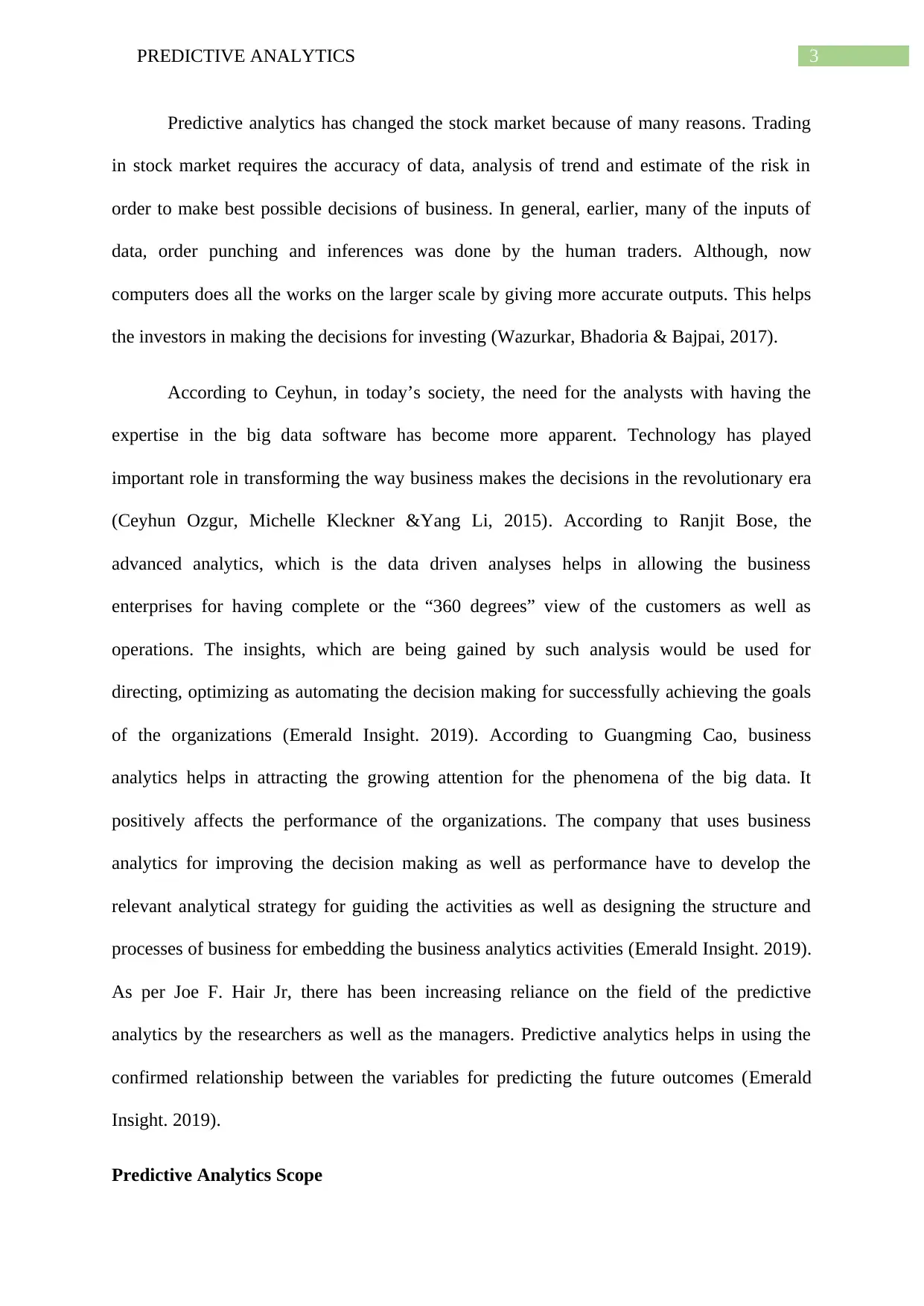
3PREDICTIVE ANALYTICS
Predictive analytics has changed the stock market because of many reasons. Trading
in stock market requires the accuracy of data, analysis of trend and estimate of the risk in
order to make best possible decisions of business. In general, earlier, many of the inputs of
data, order punching and inferences was done by the human traders. Although, now
computers does all the works on the larger scale by giving more accurate outputs. This helps
the investors in making the decisions for investing (Wazurkar, Bhadoria & Bajpai, 2017).
According to Ceyhun, in today’s society, the need for the analysts with having the
expertise in the big data software has become more apparent. Technology has played
important role in transforming the way business makes the decisions in the revolutionary era
(Ceyhun Ozgur, Michelle Kleckner &Yang Li, 2015). According to Ranjit Bose, the
advanced analytics, which is the data driven analyses helps in allowing the business
enterprises for having complete or the “360 degrees” view of the customers as well as
operations. The insights, which are being gained by such analysis would be used for
directing, optimizing as automating the decision making for successfully achieving the goals
of the organizations (Emerald Insight. 2019). According to Guangming Cao, business
analytics helps in attracting the growing attention for the phenomena of the big data. It
positively affects the performance of the organizations. The company that uses business
analytics for improving the decision making as well as performance have to develop the
relevant analytical strategy for guiding the activities as well as designing the structure and
processes of business for embedding the business analytics activities (Emerald Insight. 2019).
As per Joe F. Hair Jr, there has been increasing reliance on the field of the predictive
analytics by the researchers as well as the managers. Predictive analytics helps in using the
confirmed relationship between the variables for predicting the future outcomes (Emerald
Insight. 2019).
Predictive Analytics Scope
Predictive analytics has changed the stock market because of many reasons. Trading
in stock market requires the accuracy of data, analysis of trend and estimate of the risk in
order to make best possible decisions of business. In general, earlier, many of the inputs of
data, order punching and inferences was done by the human traders. Although, now
computers does all the works on the larger scale by giving more accurate outputs. This helps
the investors in making the decisions for investing (Wazurkar, Bhadoria & Bajpai, 2017).
According to Ceyhun, in today’s society, the need for the analysts with having the
expertise in the big data software has become more apparent. Technology has played
important role in transforming the way business makes the decisions in the revolutionary era
(Ceyhun Ozgur, Michelle Kleckner &Yang Li, 2015). According to Ranjit Bose, the
advanced analytics, which is the data driven analyses helps in allowing the business
enterprises for having complete or the “360 degrees” view of the customers as well as
operations. The insights, which are being gained by such analysis would be used for
directing, optimizing as automating the decision making for successfully achieving the goals
of the organizations (Emerald Insight. 2019). According to Guangming Cao, business
analytics helps in attracting the growing attention for the phenomena of the big data. It
positively affects the performance of the organizations. The company that uses business
analytics for improving the decision making as well as performance have to develop the
relevant analytical strategy for guiding the activities as well as designing the structure and
processes of business for embedding the business analytics activities (Emerald Insight. 2019).
As per Joe F. Hair Jr, there has been increasing reliance on the field of the predictive
analytics by the researchers as well as the managers. Predictive analytics helps in using the
confirmed relationship between the variables for predicting the future outcomes (Emerald
Insight. 2019).
Predictive Analytics Scope
Paraphrase This Document
Need a fresh take? Get an instant paraphrase of this document with our AI Paraphraser
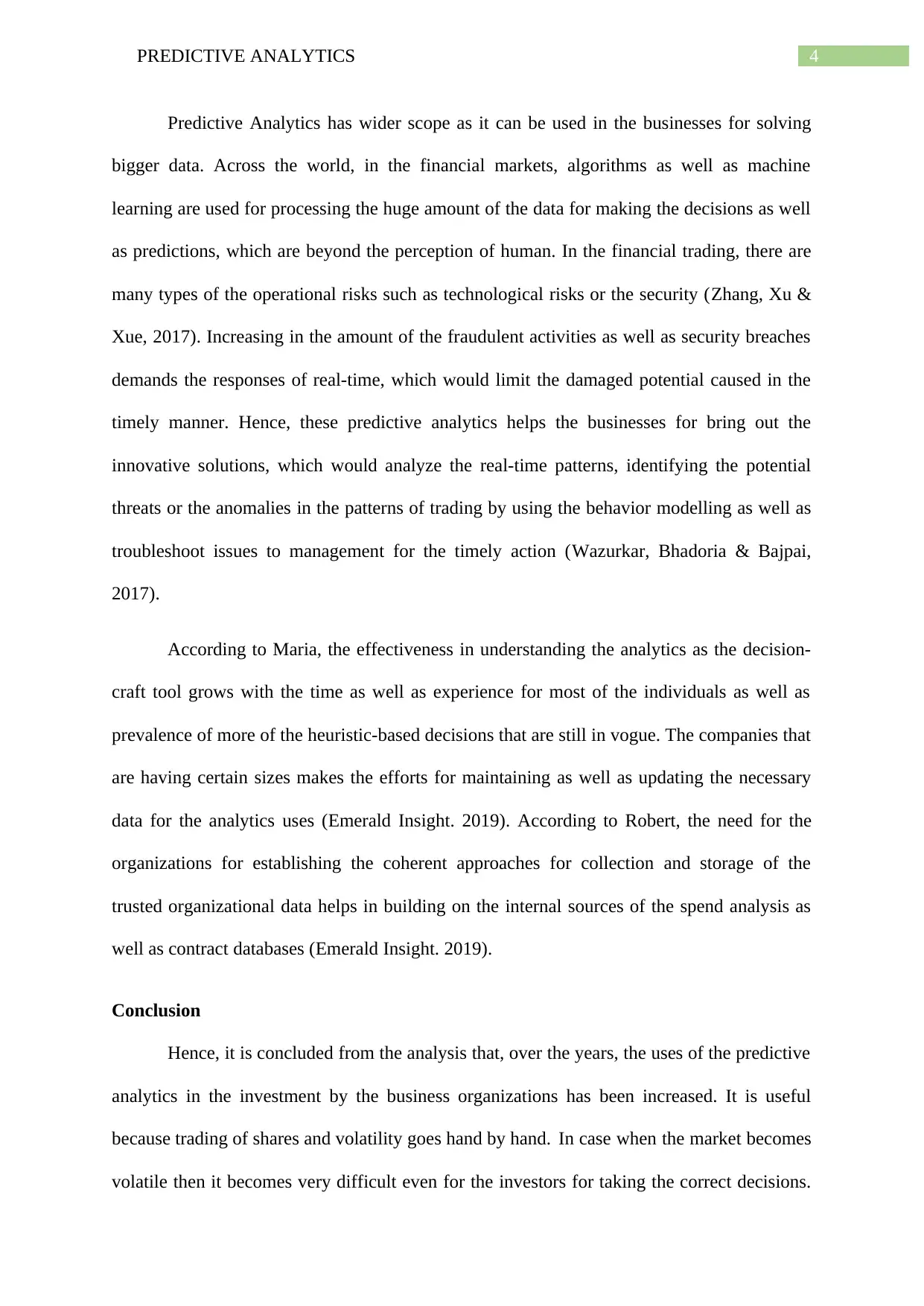
4PREDICTIVE ANALYTICS
Predictive Analytics has wider scope as it can be used in the businesses for solving
bigger data. Across the world, in the financial markets, algorithms as well as machine
learning are used for processing the huge amount of the data for making the decisions as well
as predictions, which are beyond the perception of human. In the financial trading, there are
many types of the operational risks such as technological risks or the security (Zhang, Xu &
Xue, 2017). Increasing in the amount of the fraudulent activities as well as security breaches
demands the responses of real-time, which would limit the damaged potential caused in the
timely manner. Hence, these predictive analytics helps the businesses for bring out the
innovative solutions, which would analyze the real-time patterns, identifying the potential
threats or the anomalies in the patterns of trading by using the behavior modelling as well as
troubleshoot issues to management for the timely action (Wazurkar, Bhadoria & Bajpai,
2017).
According to Maria, the effectiveness in understanding the analytics as the decision-
craft tool grows with the time as well as experience for most of the individuals as well as
prevalence of more of the heuristic-based decisions that are still in vogue. The companies that
are having certain sizes makes the efforts for maintaining as well as updating the necessary
data for the analytics uses (Emerald Insight. 2019). According to Robert, the need for the
organizations for establishing the coherent approaches for collection and storage of the
trusted organizational data helps in building on the internal sources of the spend analysis as
well as contract databases (Emerald Insight. 2019).
Conclusion
Hence, it is concluded from the analysis that, over the years, the uses of the predictive
analytics in the investment by the business organizations has been increased. It is useful
because trading of shares and volatility goes hand by hand. In case when the market becomes
volatile then it becomes very difficult even for the investors for taking the correct decisions.
Predictive Analytics has wider scope as it can be used in the businesses for solving
bigger data. Across the world, in the financial markets, algorithms as well as machine
learning are used for processing the huge amount of the data for making the decisions as well
as predictions, which are beyond the perception of human. In the financial trading, there are
many types of the operational risks such as technological risks or the security (Zhang, Xu &
Xue, 2017). Increasing in the amount of the fraudulent activities as well as security breaches
demands the responses of real-time, which would limit the damaged potential caused in the
timely manner. Hence, these predictive analytics helps the businesses for bring out the
innovative solutions, which would analyze the real-time patterns, identifying the potential
threats or the anomalies in the patterns of trading by using the behavior modelling as well as
troubleshoot issues to management for the timely action (Wazurkar, Bhadoria & Bajpai,
2017).
According to Maria, the effectiveness in understanding the analytics as the decision-
craft tool grows with the time as well as experience for most of the individuals as well as
prevalence of more of the heuristic-based decisions that are still in vogue. The companies that
are having certain sizes makes the efforts for maintaining as well as updating the necessary
data for the analytics uses (Emerald Insight. 2019). According to Robert, the need for the
organizations for establishing the coherent approaches for collection and storage of the
trusted organizational data helps in building on the internal sources of the spend analysis as
well as contract databases (Emerald Insight. 2019).
Conclusion
Hence, it is concluded from the analysis that, over the years, the uses of the predictive
analytics in the investment by the business organizations has been increased. It is useful
because trading of shares and volatility goes hand by hand. In case when the market becomes
volatile then it becomes very difficult even for the investors for taking the correct decisions.
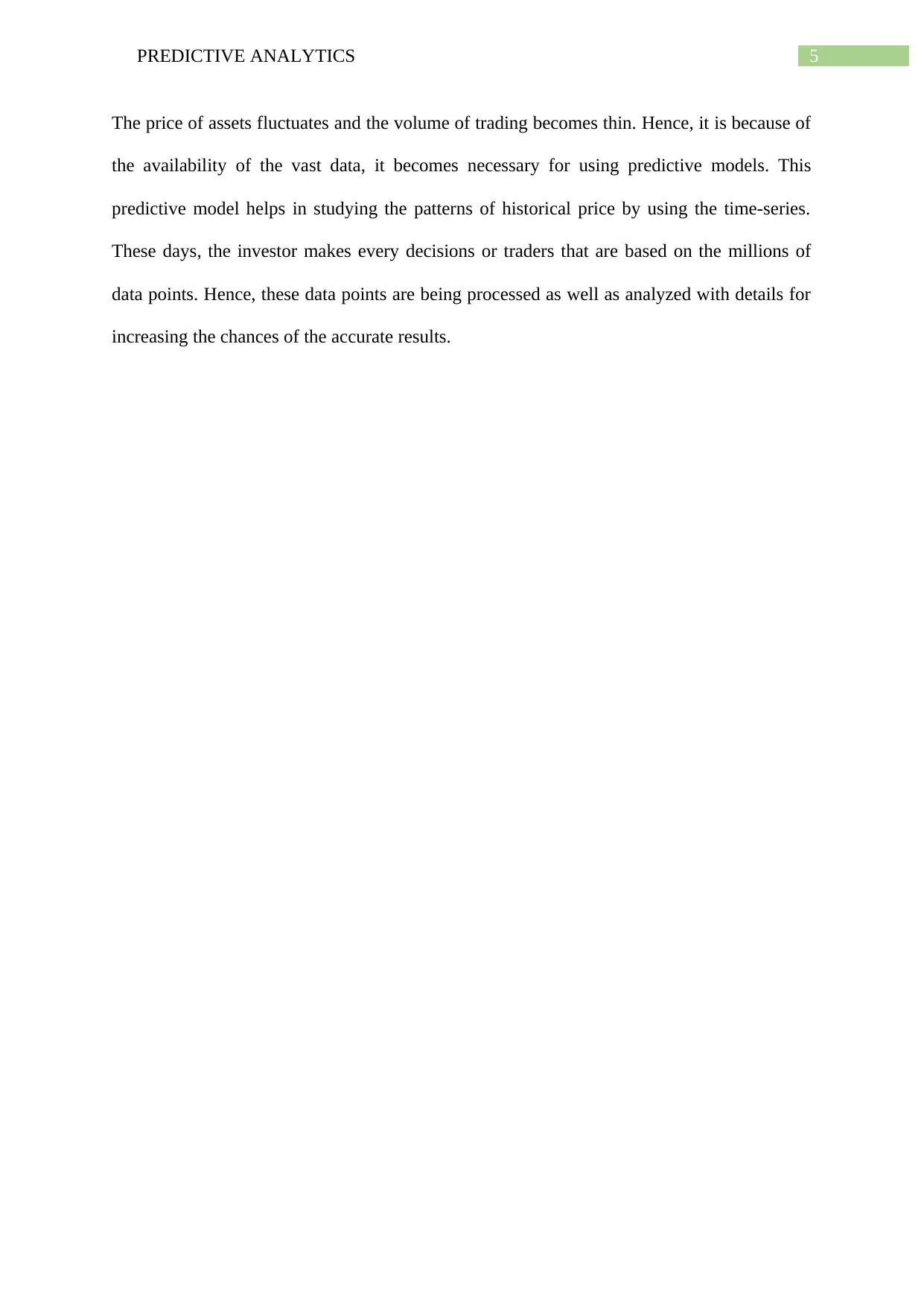
5PREDICTIVE ANALYTICS
The price of assets fluctuates and the volume of trading becomes thin. Hence, it is because of
the availability of the vast data, it becomes necessary for using predictive models. This
predictive model helps in studying the patterns of historical price by using the time-series.
These days, the investor makes every decisions or traders that are based on the millions of
data points. Hence, these data points are being processed as well as analyzed with details for
increasing the chances of the accurate results.
The price of assets fluctuates and the volume of trading becomes thin. Hence, it is because of
the availability of the vast data, it becomes necessary for using predictive models. This
predictive model helps in studying the patterns of historical price by using the time-series.
These days, the investor makes every decisions or traders that are based on the millions of
data points. Hence, these data points are being processed as well as analyzed with details for
increasing the chances of the accurate results.
⊘ This is a preview!⊘
Do you want full access?
Subscribe today to unlock all pages.

Trusted by 1+ million students worldwide
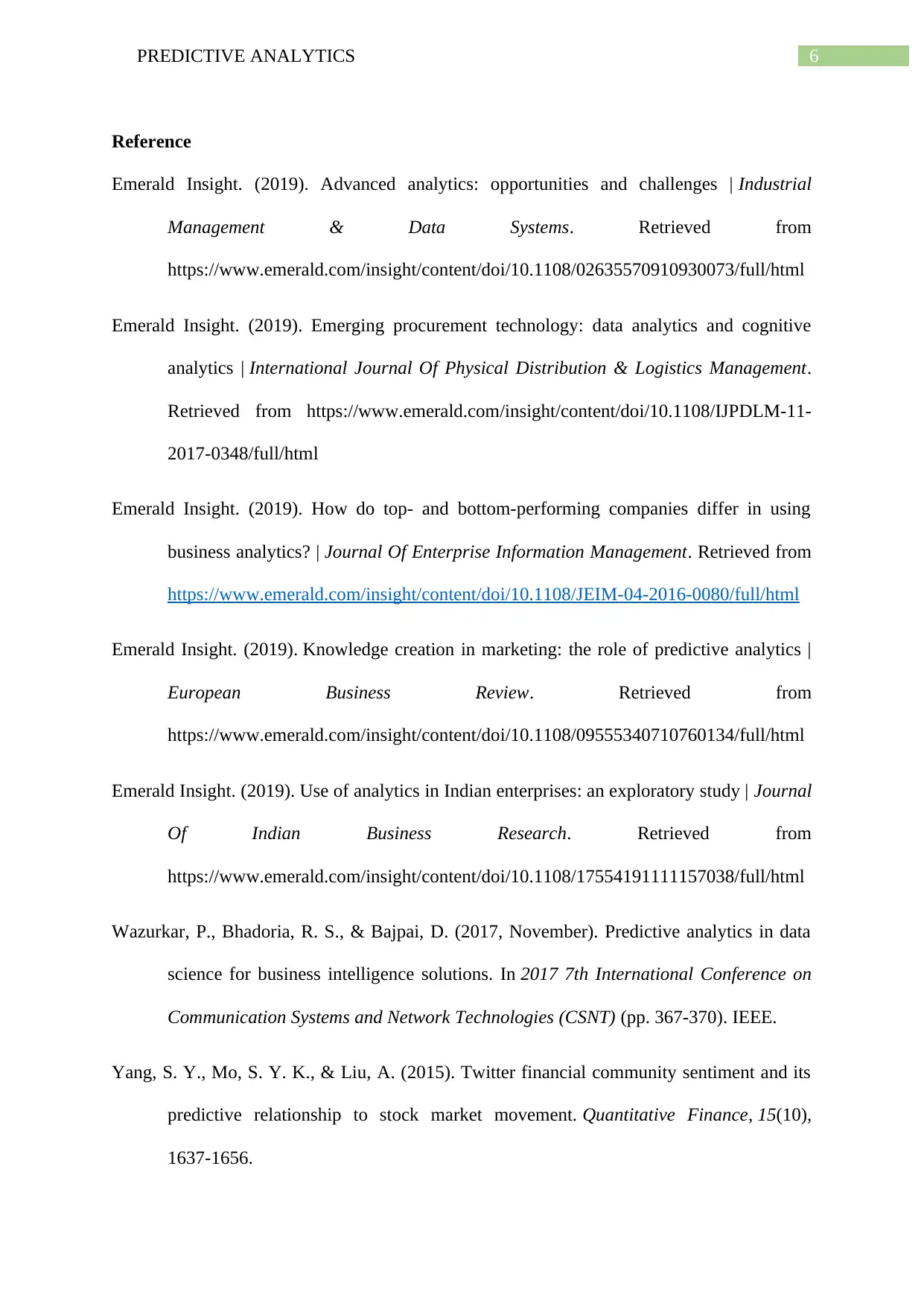
6PREDICTIVE ANALYTICS
Reference
Emerald Insight. (2019). Advanced analytics: opportunities and challenges | Industrial
Management & Data Systems. Retrieved from
https://www.emerald.com/insight/content/doi/10.1108/02635570910930073/full/html
Emerald Insight. (2019). Emerging procurement technology: data analytics and cognitive
analytics | International Journal Of Physical Distribution & Logistics Management.
Retrieved from https://www.emerald.com/insight/content/doi/10.1108/IJPDLM-11-
2017-0348/full/html
Emerald Insight. (2019). How do top- and bottom-performing companies differ in using
business analytics? | Journal Of Enterprise Information Management. Retrieved from
https://www.emerald.com/insight/content/doi/10.1108/JEIM-04-2016-0080/full/html
Emerald Insight. (2019). Knowledge creation in marketing: the role of predictive analytics |
European Business Review. Retrieved from
https://www.emerald.com/insight/content/doi/10.1108/09555340710760134/full/html
Emerald Insight. (2019). Use of analytics in Indian enterprises: an exploratory study | Journal
Of Indian Business Research. Retrieved from
https://www.emerald.com/insight/content/doi/10.1108/17554191111157038/full/html
Wazurkar, P., Bhadoria, R. S., & Bajpai, D. (2017, November). Predictive analytics in data
science for business intelligence solutions. In 2017 7th International Conference on
Communication Systems and Network Technologies (CSNT) (pp. 367-370). IEEE.
Yang, S. Y., Mo, S. Y. K., & Liu, A. (2015). Twitter financial community sentiment and its
predictive relationship to stock market movement. Quantitative Finance, 15(10),
1637-1656.
Reference
Emerald Insight. (2019). Advanced analytics: opportunities and challenges | Industrial
Management & Data Systems. Retrieved from
https://www.emerald.com/insight/content/doi/10.1108/02635570910930073/full/html
Emerald Insight. (2019). Emerging procurement technology: data analytics and cognitive
analytics | International Journal Of Physical Distribution & Logistics Management.
Retrieved from https://www.emerald.com/insight/content/doi/10.1108/IJPDLM-11-
2017-0348/full/html
Emerald Insight. (2019). How do top- and bottom-performing companies differ in using
business analytics? | Journal Of Enterprise Information Management. Retrieved from
https://www.emerald.com/insight/content/doi/10.1108/JEIM-04-2016-0080/full/html
Emerald Insight. (2019). Knowledge creation in marketing: the role of predictive analytics |
European Business Review. Retrieved from
https://www.emerald.com/insight/content/doi/10.1108/09555340710760134/full/html
Emerald Insight. (2019). Use of analytics in Indian enterprises: an exploratory study | Journal
Of Indian Business Research. Retrieved from
https://www.emerald.com/insight/content/doi/10.1108/17554191111157038/full/html
Wazurkar, P., Bhadoria, R. S., & Bajpai, D. (2017, November). Predictive analytics in data
science for business intelligence solutions. In 2017 7th International Conference on
Communication Systems and Network Technologies (CSNT) (pp. 367-370). IEEE.
Yang, S. Y., Mo, S. Y. K., & Liu, A. (2015). Twitter financial community sentiment and its
predictive relationship to stock market movement. Quantitative Finance, 15(10),
1637-1656.
Paraphrase This Document
Need a fresh take? Get an instant paraphrase of this document with our AI Paraphraser
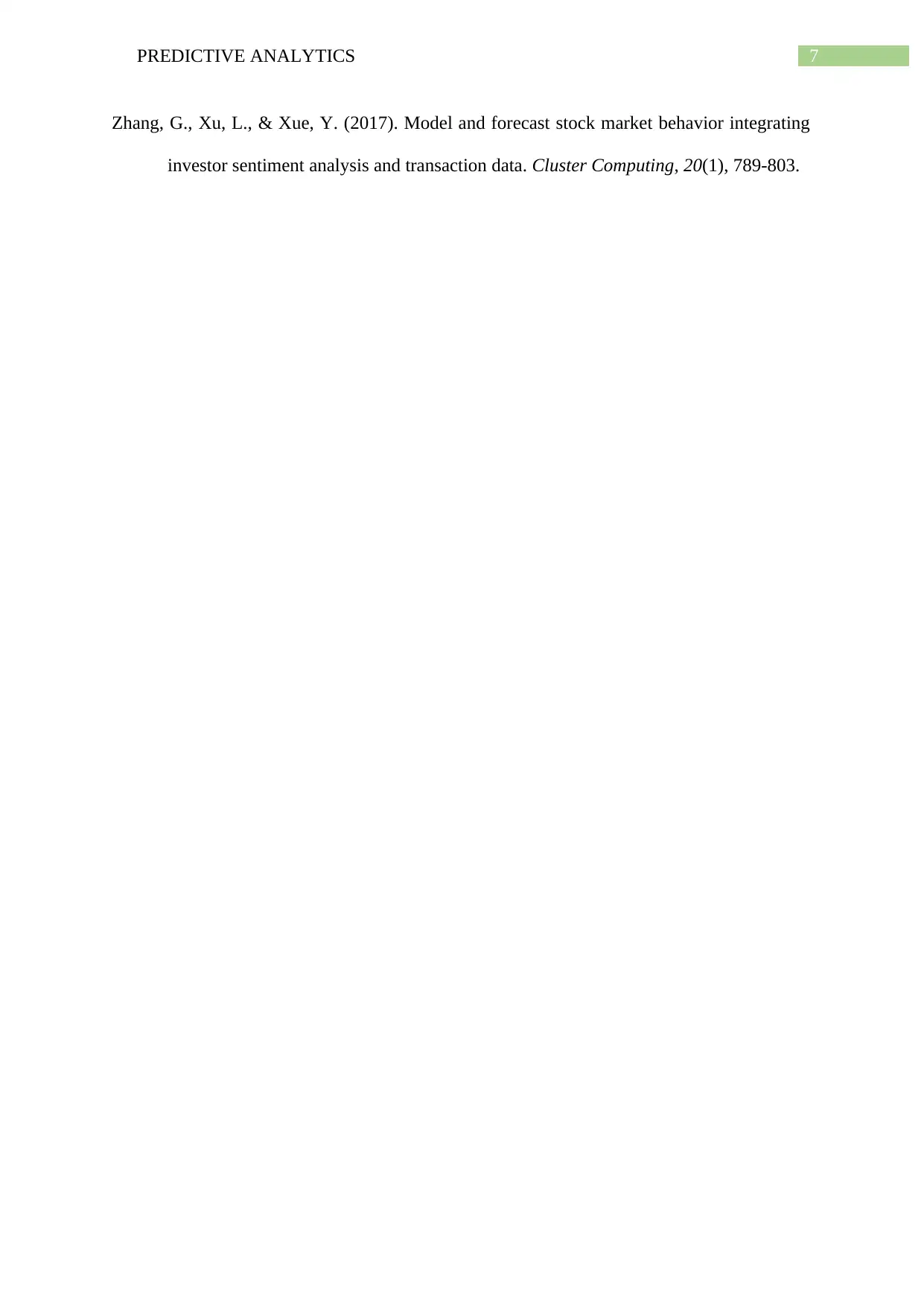
7PREDICTIVE ANALYTICS
Zhang, G., Xu, L., & Xue, Y. (2017). Model and forecast stock market behavior integrating
investor sentiment analysis and transaction data. Cluster Computing, 20(1), 789-803.
Zhang, G., Xu, L., & Xue, Y. (2017). Model and forecast stock market behavior integrating
investor sentiment analysis and transaction data. Cluster Computing, 20(1), 789-803.
1 out of 8
Related Documents
Your All-in-One AI-Powered Toolkit for Academic Success.
+13062052269
info@desklib.com
Available 24*7 on WhatsApp / Email
![[object Object]](/_next/static/media/star-bottom.7253800d.svg)
Unlock your academic potential
Copyright © 2020–2025 A2Z Services. All Rights Reserved. Developed and managed by ZUCOL.





